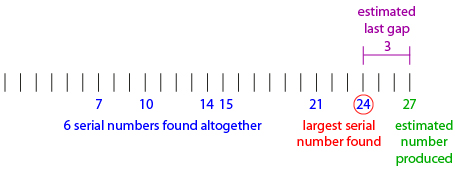Rational equations can be used to model and solve some problems. Consider the German tank problem in Try This 4.
Try This 4

iStockphoto/Thinkstock
In World War II, it was of interest to the Allies to know how many weapons, such as tanks, the Axis powers had produced. One method the Allies used to estimate this was to use the serial numbers of captured or destroyed weapons. For this strategy, the total number of serial numbers, n, and the largest serial number, m, of captured weapons were used. Two assumptions were then made using these serial numbers:
- The enemy produced at least as many as the largest serial number found.
- The number produced after the largest serial number found should be approximately the size of the average gap between serial numbers found.
As an example, suppose that the Allies recovered tanks with engine serial numbers 7, 10, 14, 15, 21, and 24. The largest number found was 24, so assume that at least 24 tanks were produced. The average gap between serial numbers can be found by dividing the number of missing serial numbers by the number of serial numbers found, as follows:

This means there are approximately 3 more tanks than the 24 known for sure, so there were approximately 27 tanks produced.

-
- Explain why
 represents the average gap of missing numbers.
represents the average gap of missing numbers. - Using m and n as described, and T to represent the estimated total number of weapons produced, write a rational equation that can be used to estimate the total number of weapons produced.
- Use your equation to estimate the total number of weapons if 22 weapons are found and the largest serial number is 5217.
- Explain why
- Begin again with the formula you created in question 1.b.

- Set m as a constant at 1000. Graph the estimated total, T, as a function of the number of weapons found, n.
- Set n as a constant at 100. Graph the estimated total, T, as a function of the largest serial number found, m.
- Which variable, m or n, appears to have a greater effect on the estimate of weapons? Explain.
-
- Suppose that the Axis powers found out what the Allies were doing and wanted to trick the Allies into thinking they had produced more weapons than they really had. If they were able to determine that the Allies had captured approximately 250 weapons of a particular type, and wanted them to believe they had 7000, what fake serial number should they let the Allies capture? Solve using a graphical method.
- How important is the estimate of 250 in determining the fake serial number in the question 3.a? Explain.
- Explain whether or not you think the Allies would have fallen for the trick.
![]() Save your responses in your course folder.
Save your responses in your course folder.
Share 3
With a partner or group, discuss the following questions based on the information from Try This 4.
- Explain any problems you see using the estimating procedure described in Try This 4.
- Describe a manufacturing method that could be used to make it harder to predict weapon numbers from serial numbers.
![]() If required, save a record of your discussion in your course folder.
If required, save a record of your discussion in your course folder.